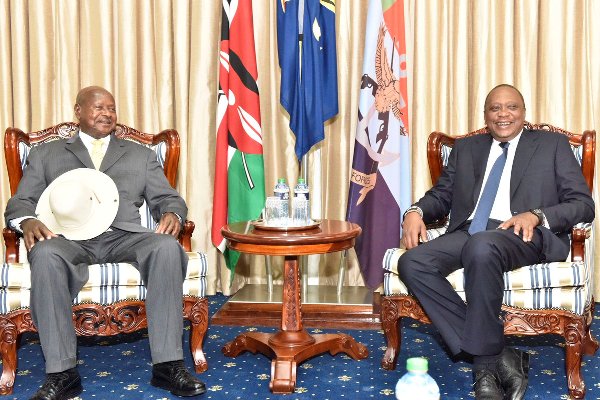Uganda’s Standard Gauge Railway is very ambitious, 39 stations and 962 km of track. The only missing component is mass transit in the major towns, Mbarara, Kampala, Jinja, Mukono and the towns on the northern route. Nevertheless the dream’s realization very much hinges Kenya’s commitments that its line, whose first phase to Nairobi was competed in June, will be extended in phases to Naivasha, Kisumu and eventually Malaba.
This seems to have now been agreed on with President Yoweri Museveni making the first visit by a Head of Government to Kenya since Mr. Kenyatta was sworn-in to start his second and final five-year term as President last month.
Mr. Museveni’s visit’s two-day visit has been highlighted by key talks progress around the Standard Gauge Railway on the Kenyan side after almost a year of being the subject of speculation with talk implying that Kenya will only stop in Kisumu. Kisumu is about 100Kms from the Kenya – Uganda border town of Malaba and for most of 2017, there has been speculation that Kenya will only stop at this point (Kisumu).
But Kenya has since recommitted to reaching Malaba after their leader President Kenyatta briefed President Museveni on investments at the Port of Mombasa, including the operation of the second container terminal, which increased the port’s overall capacity to 1.65 million containers. This is the first phase of a three-stage project, which, when completed, will bring the total capacity of the port to 2.7 million containers per year. The modernisation programme has resulted in reduced average time to import and export goods through the port of Mombasa – from 11 days to under 3.5 days, and work for even greater efficiency continues.
Kenyatta’s spokesperson Manoah Esipisu in an email added that President Museveni was also briefed on last Saturday’s commissioning of the Inland Container Depot at Embakasi. With the launch of the cargo rail freight on the Standard Gauge Railway, we expect that most goods will be transported from the Mombasa Port by train, starting in January 2018.
This will further shorten the time of moving goods from Mombasa to Kenya’s hinterland and neighbouring countries as well as the costs for doing so by a further 30 per cent.

Phase Two of the SGR from Nairobi to Naivasha is also moving on schedule and is due to be commissioned in 2019.
The financiers of the project, EXIM Bank of China, are said to only be considering granting Kenya more financing for to Kisumu, only if there is a commitment to reach Malaba.
Both Presidents agreed on working jointly on taking the SGR line from Naivasha to Kisumu and onwards to Malaba on the border with Uganda. The line to Kisumu will also serve Uganda through the Lake Victoria ports of Jinja, Masaka and Entebbe.
On his part, President Museveni told President Kenyatta that “Uganda was ready and committed to the SGR project, and would work with Kenya to achieve its commitment”.
President Museveni recently approved the borrowing of Ush10.3 trillion ($2.9 billion) for the constructionfrom the Malaba border with Kenya to Kampala in the clearest signal yet that the regional infrastructure project is back on track.
The approval for the borrowing comes amid indications that China had agreed to fund the line only if it was a joint project between governments including Rwanda, the last stop of the Northern Corridor under the East Africa Railway Masterplan.
The SGR is a pet project that came into being following a 2013 pronouncement by Presidents Paul Kagame of Rwanda, Kenya’s Kenyatta and Mr. Museveni and would complete the circuit meant to boost trade in the region with another line in the Central Corridor from Dar es Salaam to Burundi and Rwanda.
Compensation ongoing
Kasingye Kyamugambi, the SGR co-ordinator, said Uganda is providing counterpart funding of 15 per cent or $345 million largely for compensation of people affected by the project. This would take the extra borrowing to $900 million. Exim Bank wants Uganda to first compensate all those whose land is on the Malaba-Kampala SGR route before a financing agreement can be reached.
Mr. Kyamugambi said compensation was moving on smoothly noting that the only concerns will emerge as they move towards the more built-up areas with eleven districts from the Tororo are covered now.












